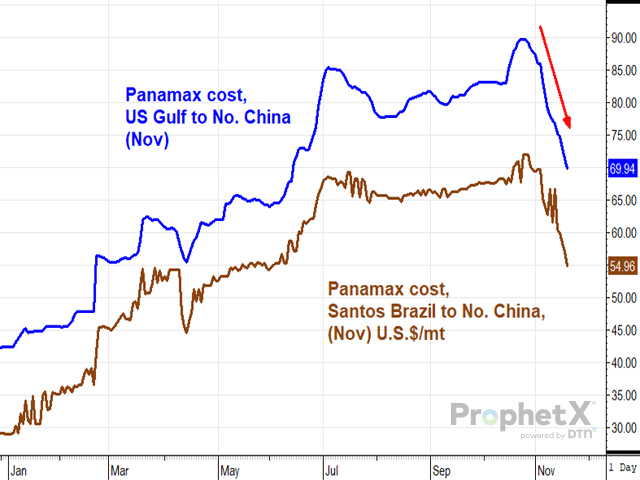Todd's Take
Grain Shipping Costs Start to Ease
Here in mid-November, corn and soybean prices have both benefitted from a shift in trader focus, going from a disappointing early start in export sales to more bullish expectations for domestic demand. For corn, USDA reported on Nov. 12 one bushel of $5.52 corn in Iowa could be processed into $8.88 worth of ethanol and $1.50 worth of distillers grains. No wonder cash corn prices are averaging $5.61 across the United States and basis shows signs of strengthening before harvest is even finished.
For soybeans, the numbers are just as enticing. On Nov. 18, USDA reported one bushel of $12.62 soybeans in Illinois could be crushed into $8.70 worth of meal and $7.65 worth of bean oil. With crush margins like that, it was no surprise Monday when the National Oilseeds Processors Association reported 184.0 million bushels (mb) of soybeans were crushed in October, the most active month since January.
The bullish demand news here in the U.S. has helped firm up a cash soybean market that drooped to a national average of $11.46 on Nov. 8, its lowest of the year. Thursday's close in the DTN National Soybean Index settled at $12.25 a bushel, down from Wednesday's new one-month high of $12.38.
As encouraging as the recent showing of domestic demand has been for corn and soybeans, we can't ignore the bearish concerns in this year's export markets. USDA's most recent report of weekly export sales showed corn commitments down 6% from a year ago and soybean commitments down 32% from a year ago. In both cases, China has the ability to dramatically change the numbers, but has yet to play its hand in 2021-22.
The other concern that has been difficult to gauge this year is the impact of higher shipping costs on U.S. exports. According to DTN ProphetX, the cost of shipping 55,000 metric tons (mt) of grain on a Panamax from the U.S. Gulf to northern China went from $42.48 mt at the end of 2020 to a high of $89.84 mt on Oct. 25, 2021. At the peak, the higher shipping cost penciled out to $2.45 a bushel for soybeans, a discouraging cost for importers.
P[L1] D[0x0] M[300x250] OOP[F] ADUNIT[] T[]
As of Nov. 18, the cost of shipping soybeans on the same Panamax had fallen to $69.94 mt or $1.90 per bushel for soybeans, a 22% drop from the October peak. Shipping costs can fluctuate like waves of the sea, but it is fair to say the pandemic-related pressures which caused shipping costs to double in 2021 are no longer getting worse. It appears the shipping cost of grain is finally normalizing as economies improve and workers get back to work.
The logistical nightmare of congested harbors and jammed ports will remain in the headlines through the holidays, but for grain shipped in bulk, there appears to be light at the end of the tunnel. This week's devastating floods around Vancouver are unfortunate for the region and have created a new set of logistical problems in Western Canada. For grain being shipped out the U.S. Gulf, however, there is reason to expect better days ahead.
For U.S. corn and soybean prices, the recent strength of domestic demand is encouraging and so is the recent easing of shipping costs. Even so, a 34% reduction in China's purchases of U.S. soybeans from a year ago still stands as the market's most bearish hurdle.
Lately, there have been bullish rumors about China buying a lot of U.S. soybeans, but reported amounts have been modest, so far. Judging by this fall's lower soybean prices in China, it is going to be difficult for U.S. domestic demand to make up for lower purchases from China. U.S. hogs and poultry can only eat so much meal.
**
Continue this conversation in person at this year's DTN Ag Summit in Chicago on Dec. 5 to 7. I will be there, talking about the challenges of markets in 2022. Even better, we have several distinguished speakers, covering lots of important topics for your farm. Find out more and register at www.dtn.com/agsummit/.
**
Comments above are for educational purposes only and are not meant as specific trade recommendations. The buying and selling of grain or grain futures or options involve substantial risk and are not suitable for everyone.
Todd Hultman can be reached at Todd.Hultman@dtn.com
Follow him on Twitter @ToddHultman1
(c) Copyright 2021 DTN, LLC. All rights reserved.



